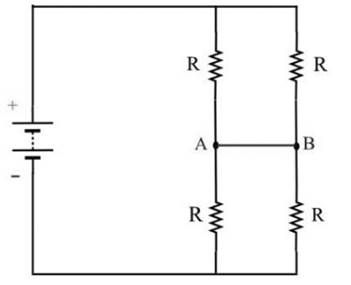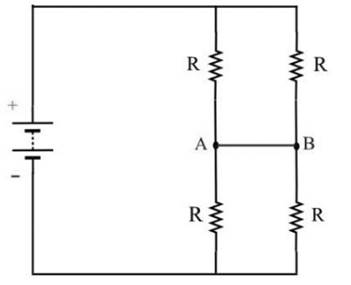
(a)
the current through the wire.
(a)
Answer to Problem 24SSC
The current in the wire is zero.
Explanation of Solution
Given:
Four resistors are connected.
The circuit diagram is

Calculation:
As the resistors on both of the line AB are identical, the point A and B are at the same potential. As there is no potential difference between the points A, B , so there will be no current in the wire connecting these two points. Hence, the current in the wire is zero.
Conclusion:
Hence, the current in the wire is zero.
(b)
the current through each resistor.
(b)
Answer to Problem 24SSC
The current through each resistor doesn’t vary.
Explanation of Solution
Given:
Four resistors are connected.
The circuit diagram is

Calculation:
As there is no current through the wire connecting AB, the circuit identical to the one without the wire. Hence, the wire doesn’t make any difference in the circuit. So, the current through resistor doesn’t vary.
Conclusion:
Hence, the current through each resistor doesn’t vary.
(c)
the current through the battery.
(c)
Answer to Problem 24SSC
Current drawn from the battery also doesn’t change.
Explanation of Solution
Given:
Four resistors are connected.
The circuit diagram is

Calculation:
The current drawn from the battery depends on the voltage of the battery and the effective resistance of the circuit only. The effective resistance of the circuit with the wire is equal to that of the circuit without the wire which is equal to R. As the effective resistance of the circuit doesn’t change, the current drawn from the battery also doesn’t change.
Conclusion:
Hence, current drawn from the battery also doesn’t change.
(d)
the potential difference across each resistor.
(d)
Answer to Problem 24SSC
The potential difference across each resistor remains the same.
Explanation of Solution
Given:
Four resistors are connected.
The circuit diagram is

Calculation:
The potential difference across each resistor remains the same.
Conclusion:
Hence, the potential difference across each resistor remains the same.
Chapter 23 Solutions
Glencoe Physics: Principles and Problems, Student Edition
Additional Science Textbook Solutions
Biology: Life on Earth (11th Edition)
Genetic Analysis: An Integrated Approach (3rd Edition)
Chemistry: An Introduction to General, Organic, and Biological Chemistry (13th Edition)
Anatomy & Physiology (6th Edition)
Brock Biology of Microorganisms (15th Edition)
Microbiology: An Introduction
- Hi, 1- Does Quantum physics theory and Newtowin physics right or wrong about Gravity? 2- How can we rewrite Quantum physics and Newtowin physics Equations?arrow_forwardHi Expert in Physics, Could you please Rewrite thses random equations using good formula of mathematics and explain each Greek alphabet and their meaning in English? Best Regards, Yahyaarrow_forwardHi Expert, I have uploaded picture, could you please name the Greek alphabet and their name in English?arrow_forward
- Hi Expert in Physics, I have uploaded pictures with respect to some physics equations. Could please name all Greek alphabet and their English name?arrow_forward81 SSM Figure 29-84 shows a cross section of an infinite conducting sheet carrying a current per unit x-length of 2; the current emerges perpendicularly out of the page. (a) Use the Biot-Savart law and symmetry to show that for all points B P P. BD P' Figure 29-84 Problem 81. x P above the sheet and all points P' below it, the magnetic field B is parallel to the sheet and directed as shown. (b) Use Ampere's law to prove that B = ½µλ at all points P and P'.arrow_forwardWhat All equations of Ountum physics?arrow_forward
- Please rewrite the rules of Quantum mechanics?arrow_forwardSuppose there are two transformers between your house and the high-voltage transmission line that distributes the power. In addition, assume your house is the only one using electric power. At a substation the primary of a step-down transformer (turns ratio = 1:23) receives the voltage from the high-voltage transmission line. Because of your usage, a current of 51.1 mA exists in the primary of the transformer. The secondary is connected to the primary of another step-down transformer (turns ratio = 1:36) somewhere near your house, perhaps up on a telephone pole. The secondary of this transformer delivers a 240-V emf to your house. How much power is your house using? Remember that the current and voltage given in this problem are rms values.arrow_forwardThe human eye is most sensitive to light having a frequency of about 5.5 × 1014 Hz, which is in the yellow-green region of the electromagnetic spectrum. How many wavelengths of this light can fit across a distance of 2.2 cm?arrow_forward
- A one-dimensional harmonic oscillator of mass m and angular frequency w is in a heat bath of temperature T. What is the root mean square of the displacement of the oscillator? (In the expressions below k is the Boltzmann constant.) Select one: ○ (KT/mw²)1/2 ○ (KT/mw²)-1/2 ○ kT/w O (KT/mw²) 1/2In(2)arrow_forwardTwo polarizers are placed on top of each other so that their transmission axes coincide. If unpolarized light falls on the system, the transmitted intensity is lo. What is the transmitted intensity if one of the polarizers is rotated by 30 degrees? Select one: ○ 10/4 ○ 0.866 lo ○ 310/4 01/2 10/2arrow_forwardBefore attempting this problem, review Conceptual Example 7. The intensity of the light that reaches the photocell in the drawing is 160 W/m², when 0 = 18°. What would be the intensity reaching the photocell if the analyzer were removed from the setup, everything else remaining the same? Light Photocell Polarizer Insert Analyzerarrow_forward
 College PhysicsPhysicsISBN:9781305952300Author:Raymond A. Serway, Chris VuillePublisher:Cengage Learning
College PhysicsPhysicsISBN:9781305952300Author:Raymond A. Serway, Chris VuillePublisher:Cengage Learning University Physics (14th Edition)PhysicsISBN:9780133969290Author:Hugh D. Young, Roger A. FreedmanPublisher:PEARSON
University Physics (14th Edition)PhysicsISBN:9780133969290Author:Hugh D. Young, Roger A. FreedmanPublisher:PEARSON Introduction To Quantum MechanicsPhysicsISBN:9781107189638Author:Griffiths, David J., Schroeter, Darrell F.Publisher:Cambridge University Press
Introduction To Quantum MechanicsPhysicsISBN:9781107189638Author:Griffiths, David J., Schroeter, Darrell F.Publisher:Cambridge University Press Physics for Scientists and EngineersPhysicsISBN:9781337553278Author:Raymond A. Serway, John W. JewettPublisher:Cengage Learning
Physics for Scientists and EngineersPhysicsISBN:9781337553278Author:Raymond A. Serway, John W. JewettPublisher:Cengage Learning Lecture- Tutorials for Introductory AstronomyPhysicsISBN:9780321820464Author:Edward E. Prather, Tim P. Slater, Jeff P. Adams, Gina BrissendenPublisher:Addison-Wesley
Lecture- Tutorials for Introductory AstronomyPhysicsISBN:9780321820464Author:Edward E. Prather, Tim P. Slater, Jeff P. Adams, Gina BrissendenPublisher:Addison-Wesley College Physics: A Strategic Approach (4th Editio...PhysicsISBN:9780134609034Author:Randall D. Knight (Professor Emeritus), Brian Jones, Stuart FieldPublisher:PEARSON
College Physics: A Strategic Approach (4th Editio...PhysicsISBN:9780134609034Author:Randall D. Knight (Professor Emeritus), Brian Jones, Stuart FieldPublisher:PEARSON





